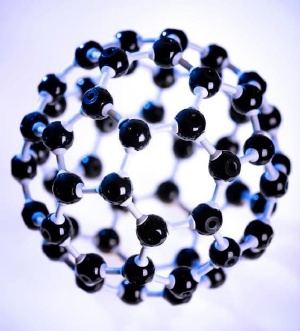May 20 2009
Rice University's Andrew Barron and his group, working with labs in Italy, Germany and Greece, have identified specific molecules that could block the means by which the deadly virus spreads by taking away its ability to bind with other proteins.
 Buckyball, or fullerene, molecular model. (Credit: iStockphoto/David Freund)
Buckyball, or fullerene, molecular model. (Credit: iStockphoto/David Freund)
Using computer simulations, researchers tested more than 100 carbon fullerene, or C60 ("buckyball"), derivatives initially developed at Rice for other purposes to see if they could be used to inhibit a strain of the virus, HIV-1 PR, by attaching themselves to its binding pocket.
"There are a lot of people doing this kind of research, but it tends to be one group or one pharmaceutical company taking a shotgun approach -- make a molecule and try it out, then make another molecule and try it out," said Barron, Rice's Charles W. Duncan Jr.-Welch Professor of Chemistry and professor of materials science. "This is interesting because we're tackling an important problem in a very rational way."
The groups reported their findings in a paper published on the American Chemical Society's Journal of Chemical Information and Modeling web site last week.
Their method of modeling ways to attack HIV may not be unique, but their collaboration is. Research groups from five institutions -- two in Greece, one in Germany, one in Italy and Barron's group at Rice -- came together through e-mail contacts and conversations over many months, each working on facets of the problem. "Not all the groups have ever met in person," Barron said. Most remarkable, he said, is that their research to date has been completely unfunded.
Using simulations to narrow down a collection of fullerenes to find the good ones is "the least time-consuming low-cost procedure for efficient, rational drug design," the team wrote.
"A long time ago, people noticed that C60 fits perfectly into the hydrophobic pocket in HIV, and it has an inhibition effect," Barron said. "It's not particularly strong, but there's potentially a very strong binding effect. The problem is, it's not the perfect unit." The objective was to find an existing fullerene derivative molecule that could be easily modified to become the perfect unit.
Rice got involved, he said, "because we make the molecules and the other guys had a great method for in-silico testing of molecules. They approached us and said, 'Do you think we could use some of these?' Then we started bouncing ideas around.
"We began thinking about a very simple experiment to calculate the binding efficiency of a molecule in the HIV pocket, then calculate that for a series of molecules, decide which one is best, make that molecule in real life and see if it correlates," Barron said. "If it does, then you've got a way to design your ultimate molecule. Our work was the first step in the process."
In fact, through their "in-silico," or computer-based, calculations, they found two good fits among the fullerene derivatives tested and are now working to enhance their binding properties to get that perfect molecule, one that sticks "like Velcro" to the virus and can be fine-tuned for various strains.
"This is just one component of the problem -- we're not going to cure HIV," Barron cautioned. The hope, he said, is to develop a method for the rapid creation of drugs to address various strains of HIV and other diseases.
Authors of the paper with Barron were Manthos Papadopoulos of the National Hellenic Research Foundation, Athens; Serdar Durdagi of the National Hellenic Research Foundation and the Freie Universitat, Berlin; Claudiu Supuran of the University of Florence, Italy; T. Amanda Strom, Nadjmeh Doostdar and Mananjali Kumar of Rice; and Thomas Mavromoustakos of the National Hellenic Research Foundation and the University of Athens.
The impromptu nature of the project intrigued Barron as much as the subject itself. "Here you've got computational people, experimental people, synthesis people, characterization people who've come together naturally as a collaboration and developed this protocol, developed their own methodologies.
"And no one's paid us to collaborate. Serdar Durdagi's graduate fellowship was funded by the European Union. The fellowships of Rice graduate students Amanda Strom, Nadjmeh Doostdar and Mananjali Kumar were funded, in part, by Rice's Center for Biological and Environmental Nanotechnology. This is purely an academic collaboration." He said the group is working on a second paper and seeking funding to expand the project.